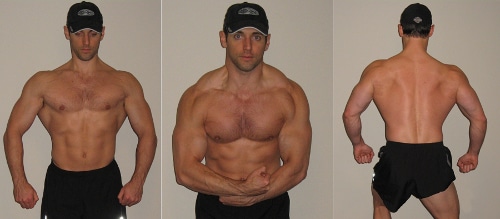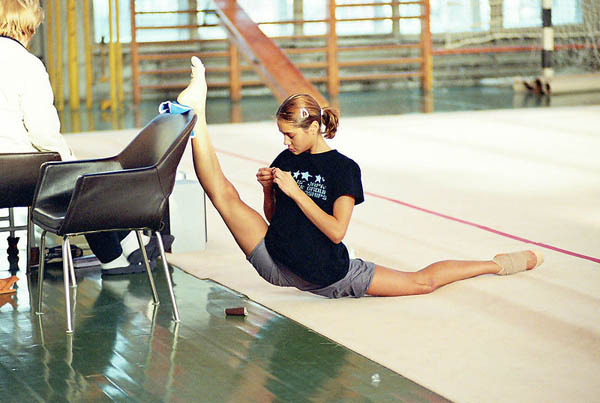Ready, Set, Fast: How Strategic Meal-Skipping Can Help You Lose Fat, Gain Muscle, and Get Healthier
 Editor’s note: This is a guest post by John Berardi, PhD.
Editor’s note: This is a guest post by John Berardi, PhD.
When we were kids, Mom was always looking out for
our health. Chew your food. Eat your vegetables. And always eat
breakfast because it’s the most important meal of the day.
As busy grown-ups, a good breakfast often falls victim to the time
crunch. Who has time to cook and eat a breakfast of champions? It’s so
much faster and more convenient to just grab a coffee and a bran muffin.
Of course, deep down we know it’s not right. Not only would Mom
disapprove, that pudgy physique in the mirror deserves better, too.
So what’s a guy to do? Get up earlier and make it happen, right? Perhaps not.
Lately, some really fit guys–men with muscles, visible veins, and abs
so sharp you can grate carrots on them–are doing something a whole lot
different. They’re not eating breakfast. Healthy or otherwise. In fact,
they’re not eating at all for extended stretches. And they’re getting
leaner, more muscular, even healthier.
This practice is called Intermittent Fasting–IF for short–and it’s
challenging everything nutritionists, dieticians, and your Mom ever told
you about healthy eating.
Going Against the Grain
Typical dietician dogma involves eating small meals
spread two to four hours apart, starting with a nutritious breakfast.
This, we’re told, stimulates the metabolism, so we burn more calories
throughout the day. It’s also supposed to make us less likely to binge
on cookies and ice cream at night.
It’s sound advice that’s been field-tested by thousands of fit, healthy, hard-bodied people.
Proponents of IF, on the other hand, eschew the idea of small,
frequent meals. They claim to have achieved quicker fat loss and better
health by deliberately skipping breakfast. Some even go entire days
without eating.
The experts are skeptical. They call IF extreme, impractical, even
harebrained–and yet no one can dispute their results. Or that the number
of IF converts is growing.
I was also a skeptic. I built my reputation on recommending small,
healthy, frequent meals, starting with breakfast. And that strategy has
definitely worked well for most of my clients.
But the track record of certain Intermittent Fasting protocols, both
in scientific publications and in real-world practice, seems pretty
impressive too. That’s why I decided to put some of these protocols to
the test. I wanted to answer the following questions: “Is IF just
another fad diet? Or is it something health and body conscious people
should consider?”
My Fasting Experiments
To this end, I spent the last 9 months testing the
most popular Intermittent Fasting protocols on myself. In the end, I
tried 8 different fasting protocols.
At times I was consuming nothing but calorie-free beverages for a
full 24-36 hours. (Mercifully that was only once per week.) Other
methods had me fasting for much shorter periods, yet more frequently.
While each method was basically a spin on not eating a thing, the
varying effects were fascinating. Some methods made me feel energized,
strong, and focused. Others simply left me lethargic, weak, and very,
very hungry.
Of the 8 different protocols I tried, there are three main variations:
The trial fast: This is where I recommend you start
if you’re interested in this approach. Just try going 24 hours without
food. I did my first trial fast on a Sunday. I set it up by having a
small meal on Saturday night at 10pm, and then didn’t eat again until
another small meal on Sunday night at 10pm. (I did drink green tea and
water throughout the day.)
The periodic fast: If you survived the trial fast
without breaking down and cleaning out the refrigerator, then you can
try this. Simply do the trial fast above once in a while. It could be
once per month. It could be once per week. (More frequently than once a
week, however, is a mistake. I tried to do it twice a week and it was a
disaster. More isn’t better.)
The daily fast: This is a more advanced way of doing
things. Here we cut the fast from 24 hours to 16-20 hours (say 8pm to
noon to 4pm the following day) but we do it every day. Ideally, most
days there’s a workout at the end of the fast, followed by some pretty
large meals during the 4-8 hour feeding window. (As complicated as this
system sounds, I found myself actually gaining muscle and losing fat at
an alarming rate.)
So what’s the conclusion? What did I learn?
Well, for body transformation, Intermittent Fasting works. Over the
course of my experiments, I dropped twenty pounds of weight, from 190
pounds to 170 pounds, and I was pretty lean to start with. I also
reduced my body fat from 10% to 4% (measured via a well-validated
ultrasound protocol) while maintaining most of my lean mass. And I kept
it off. In addition, I saw some interesting improvements in my health
profile.
You can check out my before and after pics below for some visual evidence:


Beyond vanity, the
reported health effects
of an intelligently designed Intermittent Fasting program read like a
laundry list of live longer, live better benefits including: reduced
blood lipids,
blood pressure,
markers of inflammation,
oxidative stress, and
cancer.
Increased cell turnover and repair,
fat burning,
growth hormone release, and
metabolic rate. And improved
appetite control,
blood sugar control,
cardiovascular function, and
neuronal plasticity.
Wow is right! At this point, if your wheels are turning, that’s a
good thing. But be careful. This article isn’t designed to persuade
you to try Intermittent Fasting right away. Rather, it’s designed to
simply get you thinking about your own eating plan. And, if it needs
improvement, how you can think about starting.
Fasting Best Practices
If you’re a busy guy, work 50 plus hours a week, and spend most of
your free time shuttling kids around and working the honey-do list,
working out daily and eating 6 meals a day may be challenging. So
skipping a few meals and looking like the Men’s Health cover model may
sound pretty appealing.
But not so fast. You can’t just skip meals willy-nilly and get awesome results.
Remember, some of these fasts follow very specific protocols. Just
eating haphazardly and then not eating is what gets many people
overweight in the first place. But if you’re keen on giving IF a try,
here are 9 things that you must first consider.
1. Food choices matter. Just because you’re not
eating often doesn’t mean the basic rules of good nutrition don’t apply.
Fasting for 20 hours and then spending 4 hours eating pizza, Twinkies,
and half your kid’s Halloween loot won’t get you lean. You need to focus
on good sources of protein, healthy fats, high quality carbohydrates,
and lots of fruits and veggies. (Your mom was right about that one.)
2. Be patient. If you’re a big fan of breakfast,
fasting is going to be a major test of willpower–especially for the
first few weeks. In my case, the early stages left me suffering from
massive stomach rumblings, hunger cravings, and big-time morning
moodiness. I did my best to stave off the breakfast cravings with a few
cups of green tea or coffee, but I still felt really bad. Luckily, I
told my friends and family what was going on, and they’re a pretty
understanding bunch. But here’s the good part. It gets better–much
better–after 14 days or so. Stick it out. You’re not dying –you’re just
hungry.
3. Exercise helps. The best fasting
protocols had me hitting the gym as hard as ever, empty stomach be
damned. There’s a reason for that –exercise drives the fat loss bus.
4. Timing is everything, but not the only thing. I
experienced the best results when I fasted for around 16-hours per day,
followed by an 8 hour eating window. I usually ended my 16-hour fasts
with a workout. Then I ate my largest meal of the day. However, other
less stringent protocols also delivered results. Experimentation is the
key.
5. Progress slowly. It’s important to start with the
trial fast and allow yourself to get “good at it” before graduating to
more frequent or complicated fasting protocols. Many find going just a
few hours without eating unbearable. It takes practice and willpower, so
be patient. Dominate the easy steps before moving further up the
fasting ladder.
6. Don’t overdo it. In my case, after achieving
great results with a weekly fast, I tried doubling the frequency to
twice a week to see if I’d get twice the results. It didn’t happen. More
isn’t necessarily better.
7. Eat meat. I ate upwards of three pounds of meat a
day to get my calorie and protein requirements. Now, I’ve always been
an omnivore, but during extended fasts, where meals are so infrequent,
eating meat is even more important. Of course, you can still do this if
you’re following a vegetarian diet. It’s just more difficult to meet
your calorie needs for the day.
8. It’s still a lifestyle. There are no diets, only
lifestyles. And any diet that you couldn’t theoretically follow for the
rest of your life is doomed to failure. During my first few fasts I was
convinced that there was no way I could eat like this for life. But
after a few weeks, I was loving it, and it was a breeze.
9. Some shouldn’t do it. I think anyone and everyone
should attempt the trial fast. Trust me, you learn a lot about yourself
when you go without food for a full day. However, for the more regular
or more extreme forms of fasting, I’ve found they’re more successful
when:
- You have a history of monitoring calorie/food intake (i.e. you’ve “dieted” before).
- You’re an experienced exerciser.
- You’re single or you don’t have children.
- Your partner (if you have one) is extremely supportive.
- Your job allows you to have periods of low performance while you adapt to a new plan.
Granted, these are just observations. There are folks who have kids,
busy careers, and tons of responsibility who love IF. And again, the
real rough period usually ends after two weeks or so. However, if it’s
not for you, it’s not for you. Again, there are other ways to eat and
exercise to develop a lean, strong, healthy body.
Remember the Basics
One more thing. It’s important to remember that
there’s
no magic pill (or magic eating plan), and when all’s said and done,
mastering the basics is still your best approach. What are the basics?
- Eating good quality food. Fresh, unprocessed, nutrient-dense food is
a must, regardless of eating style. So make food awareness a priority
and make the best choices you can afford.
- Eating slowly. Rushing through meals impairs digestion and confuses
satiety centers in the brain. So slow down. It helps control intake
and improve your enjoyment of eating.
- Eating reasonable portions. When calories are controlled, progress
is made. Overeating is still possible with IF, just as it is with every
other eating style. So pay attention to food amount.
- Eating when you’re hungry, and not eating when you’re not. Learning
to tune into your appetite and listen to your true hunger is important.
Using mindfulness during meals is a best practice for healthy eating.
- Regular exercise. Of course, exercise and healthy eating are two
sides of the same coin. They both help promote health and a lean body
but in different ways. So use both.
Interestingly, these things are enough for most people to get in the
best shape of their lives. No Intermittent Fasting required. I know
that because I’ve been in this business for 20 years and have helped a
lot of clients achieve success in fat loss and improving health. Very
few of them did any more than the trial fast, but all of them are taught
those essentials. So, if you’re a beginner, please start with these.
However, if you’re a little further down the fitness path, I will say
this. For a very specific demographic–people with fitness and exercise
experience who also consider breakfast 15 minutes they’ll never get
back–IF could be a very effective approach. Maybe even the best
approach.
Just don’t tell Mom, okay?
_______________________________________
If you’re intrigued by Intermittent Fasting and want to learn
more, Dr. Berardi has published an absolutely free e-book on the subject
called Experiments with Intermittent Fasting.
In the book, he gets into all the different fasting approaches he
tried, including details of his exercise programs and his exact eating
plans, as well as which ones could work best for you. There’s also a
great section on nutrition best practices and self-experimentation.


























 You've bought everything on your list, and now you're standing in the
kitchen, broke, with eight bags of groceries and no clue what to do.
You've bought everything on your list, and now you're standing in the
kitchen, broke, with eight bags of groceries and no clue what to do. 



















